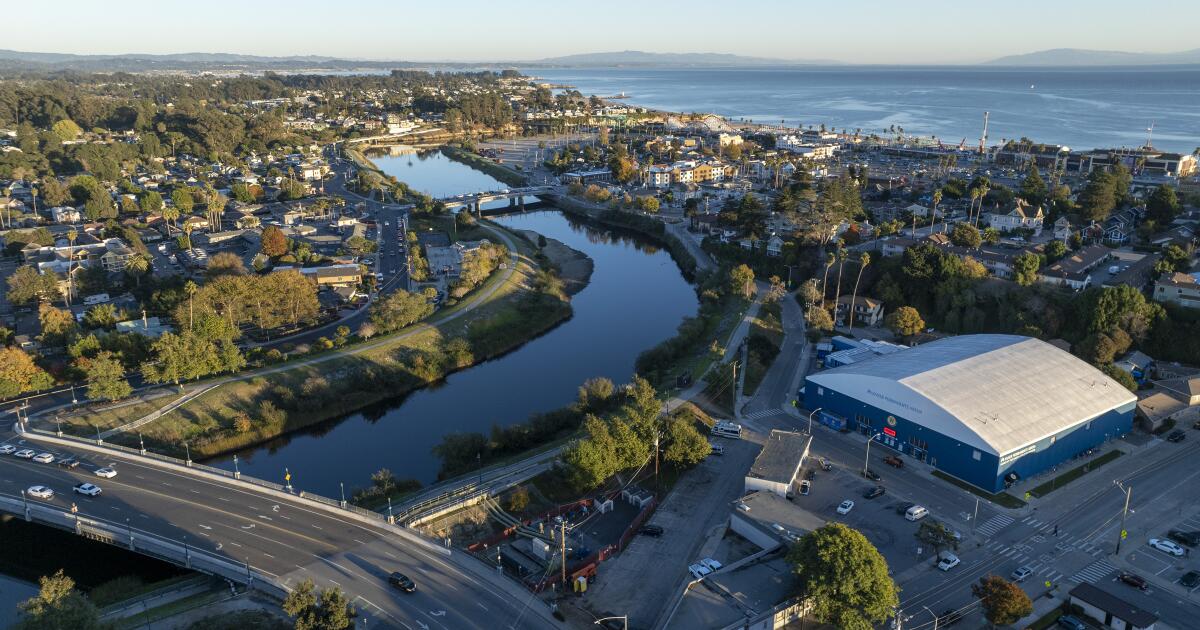After part of a plane’s wall blew out, feds ground some Boeings
Alaska and United Airlines, which use the jets, have begun inspections, the carriers said. The blowout, which the National Transportation Safety Board upgraded from an “incident” to an “accident” Saturday night, caused dozens of flight cancellations, and checks are expected to continue into this week.
On the Alaska Airlines flight on Friday, a door plug blew out partway down the plane, leaving a gaping hole beside a row of seats, according to the FAA, experts and images captured by passengers. Some on board described pieces of debris flying around and frigid air rushing in as the pilots made an emergency landing.
No passengers were sitting directly adjacent to the door plug, but the headrests of two seats and the back of one were discovered to be missing after the accident, said Jennifer Homendy, chair of the National Transportation Safety Board.
“We are very, very fortunate here that this didn’t end up in something more tragic,” she said at a news conference Saturday evening.
When asked by a reporter whether investigators would examine Boeing’s manufacturing process or the FAA’s oversight of Boeing, Homendy said, “Nothing is excluded.”
The United States has “the safest aviation system in the world,” she said. “But we have to maintain that standard.”
The flight, which was carrying 171 passengers and six crew members, landed safely in Portland, Ore., at the airport from which it had taken off. One flight attendant suffered minor injuries, according to the union that represents Alaska crews. Several passengers required medical attention for injuries resulting from the midair emergency, the airline said.
“It was terrifying,” passenger Elizabeth Le, 20, a college student who was on a trip with friends, said in an interview.
Federal regulators announced plans to investigate the cause of the accident, which was not immediately clear. In the emergency order, the FAA said it was taking action because the “departure of a mid-cabin door plug” had caused rapid decompression on the plane.
The agency said the problem “could result in injury to passengers and crew, the door impacting the airplane, and/or loss of control of the airplane.”
“The FAA is requiring immediate inspections of certain Boeing 737-9 Max planes before they can return to flight,” FAA Administrator Michael Whitaker said.
Boeing said in a statement Saturday afternoon that it supported the FAA’s decision.
Alaska Airlines grounded its 65 Boeing 737-9 Max planes for inspections as a precaution immediately following the accident. It had canceled 160 total flights as of 7 p.m. Eastern time Saturday, affecting about 23,000 customers, and said the disruption could last through at least midweek.
Eighteen jets that had recently undergone major maintenance, including inspections of the plug door, continued to be in service Saturday until the FAA’s directive was received, Alaska said in an update. “These aircraft have now also been pulled from service until details about possible additional maintenance work are confirmed with the FAA,” the update added.
United Airlines said in an update Saturday night that it had temporarily suspended service on all Boeing 737-9 Max aircraft so the FAA-ordered inspections could be completed. United had canceled more than 100 flights as of Saturday night, according to FlightAware, a flight tracking website.
United has 79 Boeing 737-9 Max aircraft in its fleet, the most of any U.S. carrier.
The National Transportation Safety Board on Saturday said a team of experts landed in Portland to launch an investigation. Transportation Secretary Pete Buttigieg said on social media that he had been briefed on the situation. The FAA will work with the board on the investigation, he added.
The accident is likely to put Boeing and its widely used 737s under fresh scrutiny. The aircraft was grounded after two 737 Max planes crashed in 2018 and 2019, killing 346 people, which led federal regulators to order Boeing to fix design flaws implicated in the crashes. The FAA eventually deemed the jets safe to fly again in 2020.
It is also a test for the FAA, which lawmakers have criticized for its handling of the 2018 and 2019 crashes and its process for reviewing the safety of the Max. The agency has attempted to strengthen its oversight of Boeing since those incidents.
The past year has brought a string of incidents that have raised broader airline safety concerns. Multiple near-collisions on U.S. runways raised alarms and put safety under deeper scrutiny, including a safety review by the FAA. Rising passenger demand since the coronavirus pandemic has collided with labor shortages, outdated technology and worker fatigue to pose safety risks, The Washington Post has reported.
On Tuesday, a Japan Airlines passenger jet burst into flames on a Tokyo airport runway after colliding with a coast guard plane, killing five people.
Investigators at the FAA and NTSB were likely to move “very swiftly” to diagnose the “unusual failure” on the Portland flight, said Graham Braithwaite, professor of safety and accident investigation at Britain’s Cranfield University.
“I would say that operators, the regulator and manufacturer will all be taking this event extremely seriously,” he said.
Alaska Airlines has 231 Boeing 737 planes, which are an average of 9.7 years old.
Outside the United States, several airlines also announced plans to ground their Boeing 737-9 Max jets until inspections are completed, including Panamanian carrier Copa Airlines and Mexican flag carrier Aeromexico.
The Emirati government-owned FlyDubai said the three Boeing 737-9 Max jets in its fleet have a different configuration in which the mid-cabin exits are used, but added that it would follow any guidance issued by Boeing. The U.K. Civil Aviation Authority said no Boeing 737-9 Max jets are registered in the country, but it is asking foreign carriers to complete inspections before operating in U.K. airspace.
The flight was headed to Ontario, Calif., a Los Angeles-area airport. It took off from Portland around 5:06 p.m. Pacific time and reached 16,300 feet before descending, according to flight data published by the flight-tracking website Flightradar24.
Air traffic control recordings captured the frantic moments in which one of the plane’s pilots declared an emergency and requested an urgent return to Portland.
“We just depressurized; we’re declaring an emergency,” the Alaska pilot told air traffic controllers, according to recordings from LiveATC.net. “We need to descend down to 10,000.”
“There was a really loud bang … and then a whoosh noise and all the air masks dropped,” passenger Evan Smith told Fox12 Oregon after getting off the flight. “It was about as wide as a refrigerator” he added, describing the size of the hole.
Le also recalled an “extremely loud pop” as oxygen masks were deployed. Remnants of the wall were “flying everywhere,” and the wind was “extremely loud and cold,” she said.
“Everyone was shaken up but we all remained calm and buckled in our seats,” Le, a psychology student, added.
Fellow passenger Kyle Rinker tweeted: “I was right across from it, it was scary as hell,” noting that the seat beside the hole had been empty. “It was so cold with all that air coming in.”
The Association of Flight Attendants, which represents crews at Alaska, said members on board had “described the decompression as explosive.”
The Air Line Pilots Association council representing Alaska crews said it was happy everyone on board the plane was safe. “We commend the flight crew for their professionalism and skill in handling the decompression event,” the union said in a statement.
The pilot on Friday’s flight requested assistance on the ground and in subsequent broadcasts calmly repeated back instructions as the plane made its way to the airport. It landed about 20 minutes after taking off, according to Flightradar24.
This is the door (in the red circle) that separated from the aircraft (image not the same registration, but same aircraft type).
Alaska’s 737-9 MAX seating configuration is not dense enough to require the mid-aft cabin exit, so the door is deactivated and standard sidewall… pic.twitter.com/nXUHSoymBY
— Flightradar24 (@flightradar24) January 6, 2024
The plane made a safe emergency landing, said Allison Ferre, a spokeswoman for the Port of Portland, which oversees Portland International Airport. The FAA confirmed that the crew of Flight 1282 had “reported a pressurization issue.”
The part of the plane that came off appeared to be a rear cabin exit door behind the wings, the location of which corresponded with the missing section visible in passengers’ photos and videos, according to experts who analyzed images and Flightradar24.
“It was a clean break that perfectly matched the outline of the mid-aft exit door,” said Jeff Guzzetti, a former accident investigator with the FAA and NTSB.
That particular door is required when a plane is carrying a certain number of passengers, but because the Alaska aircraft was designed to carry a smaller number of passengers, the door was not required to be activated. It would have been paneled over to look like a regular passenger seat with a window, Guzzetti said.
The aircraft that made the emergency landing Friday was delivered from Boeing on Oct. 31 last year. It entered service in the following month and has made 145 flights since then, according to Flightradar24.
Whether the accident signifies a larger issue — and trouble for Boeing and its 737 Max planes — remains to be seen, experts said.
It could be an isolated incident, said John Rose, chief risk and security officer at Altour, a travel management company, who said this type of problem is “extremely rare.” But if it’s a systemic manufacturing issue, then it could have “just exposed a failure.”
In Guzzetti’s assessment, that could be the case. Guzzetti said it could have been caused by a structural or mechanical issue, meaning it may be a manufacturing defect rather than a maintenance problem.
“Boeing has been plagued with a spate of manufacturing problems. Not just with the Max, but with the 787 as well,” he told The Post. “It certainly could point to some significant deficiencies in Boeing’s production process and production quality.”
Rep. Rick Larsen (D-Wash.), ranking minority-party member of the House Transportation and Infrastructure Committee, said he would continue to monitor the situation and be ready to work with lawmakers on any policy changes needed.
“Safety must come first for our aviation system, which is why I’m pleased that NTSB has already announced an investigation into the incident in Portland,” Larsen said. “I also support the FAA’s decision to issue an airworthiness directive grounding this subset of planes until they can be inspected for safety.”
Rep. Norma J. Torres (D-Calif.), who represents the district that includes Ontario International Airport, sent a letter to Whitaker requesting additional information about what steps the agency would take to address safety concerns about the aircraft and how long the temporary grounding would last.
Le, the passenger, said she was put on the next Alaska Airlines flight to Ontario on Friday night and had received a refund and “additional” compensation.
Even so, she remained wary of boarding another plane. “Not sure how we got through it,” she said, “but we did end up at our destination safely.”







